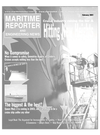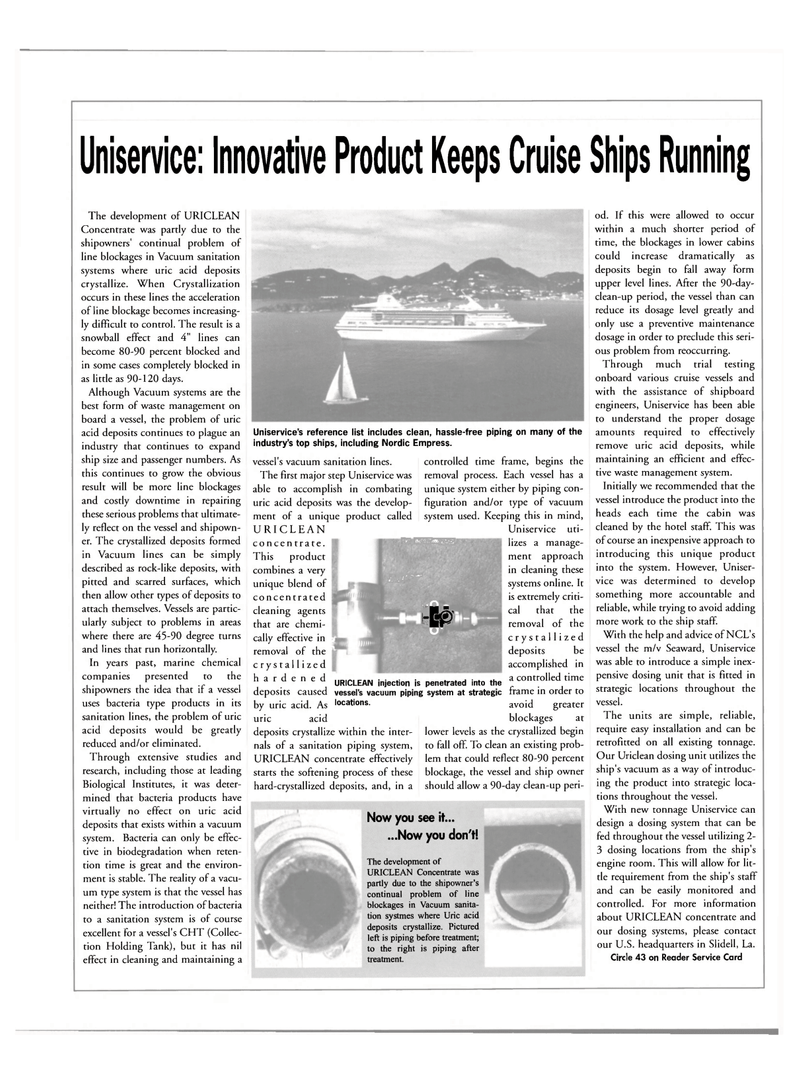
Page 39: of Maritime Reporter Magazine (February 2001)
Read this page in Pdf, Flash or Html5 edition of February 2001 Maritime Reporter Magazine
Uniservice: Innovative Product Keeps Cruise Ships Running
The development of URI CLEAN
Concentrate was partly due to the shipowners' continual problem of line blockages in Vacuum sanitation systems where uric acid deposits crystallize. When Crystallization occurs in these lines the acceleration of line blockage becomes increasing- ly difficult to control. The result is a snowball effect and 4" lines can become 80-90 percent blocked and in some cases completely blocked in as little as 90-120 days.
Although Vacuum systems are the best form of waste management on board a vessel, the problem of uric acid deposits continues to plague an industry that continues to expand ship size and passenger numbers. As this continues to grow the obvious result will be more line blockages and costly downtime in repairing these serious problems that ultimate- ly reflect on the vessel and shipown- er. The crystallized deposits formed in Vacuum lines can be simply described as rock-like deposits, with pitted and scarred surfaces, which then allow other types of deposits to attach themselves. Vessels are partic- ularly subject to problems in areas where there are 45-90 degree turns and lines that run horizontally.
In years past, marine chemical companies presented to the shipowners the idea that if a vessel uses bacteria type products in its sanitation lines, the problem of uric acid deposits would be greatly reduced and/or eliminated.
Through extensive studies and research, including those at leading
Biological Institutes, it was deter- mined that bacteria products have virtually no effect on uric acid deposits that exists within a vacuum system. Bacteria can only be effec- tive in biodegradation when reten- tion time is great and the environ- ment is stable. The reality of a vacu- um type system is that the vessel has neither! The introduction of bacteria to a sanitation system is of course excellent for a vessel's CHT (Collec- tion Holding Tank), but it has nil effect in cleaning and maintaining a
Uniservice's reference list includes clean, hassle-free piping on many of the industry's top ships, including Nordic Empress. vessel's vacuum sanitation lines.
The first major step Uniservice was able to accomplish in combating uric acid deposits was the develop- ment of a unique product called
URICLEAN controlled time frame, begins the removal process. Each vessel has a unique system either by piping con- figuration and/or type of vacuum system used. Keeping this in mind,
Uniservice uti- , • • concentrate.
This product combines a very unique blend of concentrate d cleaning agents that are chemi- cally effective in removal of the crystallized hardened URICLEAN injection is deposits caused vessel's vacuum piping by uric acid. As locations. uric acid deposits crystallize within the inter- nals of a sanitation piping system,
URICLEAN concentrate effectively starts the softening process of these hard-crystallized deposits, and, in a * V:KTM Mrs lizes # a manage- ment approach in cleaning these systems online. It is extremely criti- cal that the removal of the crystallized deposits be accomplished in a controlled time frame in order to avoid greater blockages at lower levels as the crystallized begin to fall off. To clean an existing prob- lem that could reflect 80-90 percent blockage, the vessel and ship owner should allow a 90-day clean-up peri- penetrated into the system at strategic
Now you see it... ...Now you don't!
The development of
URICLEAN Concentrate was partly due to the shipowner's continual problem of line blockages in Vacuum sanita- tion systmes where Uric acid deposits crystallize. Pictured left is piping before treatment; to the right is piping after treatment. od. If this were allowed to occur within a much shorter period of time, the blockages in lower cabins could increase dramatically as deposits begin to fall away form upper level lines. After the 90-day- clean-up period, the vessel than can reduce its dosage level greatly and only use a preventive maintenance dosage in order to preclude this seri- ous problem from reoccurring.
Through much trial testing onboard various cruise vessels and with the assistance of shipboard engineers, Uniservice has been able to understand the proper dosage amounts required to effectively remove uric acid deposits, while maintaining an efficient and effec- tive waste management system.
Initially we recommended that the vessel introduce the product into the heads each time the cabin was cleaned by the hotel staff. This was of course an inexpensive approach to introducing this unique product into the system. However, Uniser- vice was determined to develop something more accountable and reliable, while trying to avoid adding more work to the ship staff.
With the help and advice of NCL's vessel the m/v Seaward, Uniservice was able to introduce a simple inex- pensive dosing unit that is fitted in strategic locations throughout the vessel.
The units are simple, reliable, require easy installation and can be retrofitted on all existing tonnage.
Our Uriclean dosing unit utilizes the ship's vacuum as a way of introduc- ing the product into strategic loca- tions throughout the vessel.
With new tonnage Uniservice can design a dosing system that can be fed throughout the vessel utilizing 2- 3 dosing locations from the ship's engine room. This will allow for lit- tle requirement from the ship's staff and can be easily monitored and controlled. For more information about URICLEAN concentrate and our dosing systems, please contact our U.S. headquarters in Slidell, La.
Circle 43 on Reader Service Card

 38
38

 40
40
